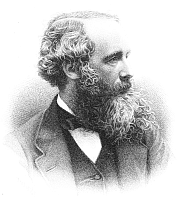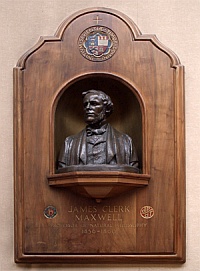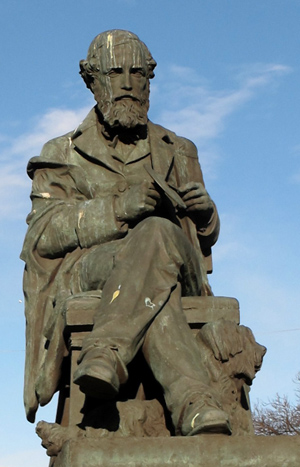
 |
James Clerk Maxwell: Concepts and Places | Maxwell Legacies |
|---|
What's in these pages? |
Few physicists would disagree that James Clerk Maxwell (1831 - 1879) stands out as the greatest 19th century physicist. This in a century that produced many notable names and discoveries. It is a tribute to some of his work that a range of phenomena, techniques and concepts are named after him. Some relate very directly to his science, others were named in the 20th century to commemorate his work. For each item in the list below there is a single web page, hopefully explaining the term. Of course there is a lot more on the web about all these and an even longer list of Maxwell tributes in Wikipedia. The text in the pages linked below is largely independent of Wikipedia. Maxwell also made contributions in other fields that to my knowledge have no specific Maxwell named item. Among these are control theory and geographic topography. There are a few 'googlies' around too. The 'Maxwell motor', so called by quite a few, was devised by Faraday. I have included only an occasional reference for each entry although I have a large archive including all of Maxwell's work and most of the books dedicated exclusively to him and his output. Anyone wishing to follow up a topic will find plenty of further references on the web. The first place to visit is the pages of the James Clerk Maxwell Foundation, based in the house where Maxwell was born in Edinburgh. They have a wide range of material including articles, videos of lectures by Maxwell scholars and images. Just in case it's not obvious, I'll add that my explanations are personal and do not represent the views of any body that hosts these web pages. Uncredited images were created by myself. One of my sons looking at a draft said "you use a lot of long words". Well, yes. That comes with the territory. These pieces are aimed at the technically literate who don't know about any particular topic. Some of the 'nutshell' entries are clearly coconut shells, rather bigger than originally intended. Brevity is not always a recipe for intelligibility. On the whole my pieces are far less technical than the 9th edition of the Encyclopaedia Britannica that Maxwell contributed to on a range of subjects in the 1870s. On many topics this publication aimed to take the reader from novice to near professional competence. My aims are much less lofty. |
 Maxwell's bust in the University of Aberdeen Maxwell's bust in the University of Aberdeen |
|---|
| Maxwell list |
ScienceFeaturesNamed specifically after James Clerk Maxwell is Clerk Maxwell Road in Cambridge, Clerk Maxwell Crescent in Aberdeen, Route Maxwell at CERN. I'll add others I hear about. The James Clerk Maxwell Building in Edinburgh University makes it totally clear who is being honoured, as does the James Clerk Maxwell Building at King's College, London: likewise the James Clerk Maxwell telescope for sub-mm astronomy in Hawaii. The Maxwell Centre in Cambridge, opened in 2015, is also named after James Clerk Maxwell but that is less obvious with the abbreviated name. As well as buildings, there are rooms, at least four prestigious prizes (IoP; General Atomics/APS; James Clerk Maxwell Foundation/Taylor & Francis; IEEE/RSE Maxwell awards including gold medal) and technological companies named after James Clerk Maxwell. ESA have the Maxwell Chamber at their ESTEC research facility, a 12 m test room for whole satellites that screens external EM radiation and whose walls absorb internal radiation, simulating the void of space. There is a memorial plaque to Maxwell in the nave of Westminster Abbey, unveiled in the centenary year of his birth (with the simple inscription alibi sepulti, namely 'buried elsewhere'). You will find him in the Scottish Engineering Hall of Fame. None of this recognition happened in his lifetime or even in his century. JSR 2016 |
 Maxwell's statue in George Street, Edinburgh
Maxwell's statue in George Street, Edinburgh |
|---|